
The genus Argiope includes rather large spiders that often have a strikingly coloured abdomen. These spiders are distributed throughout the world. Most countries in tropical or temperate climates host one or more species that are similar in appearance. The etymology of Argiope is from a Latin word argentum meaning silver. The carapace of Argiope species is typically covered in silvery hairs, and when crawling in the sun, they reflect it in a way that gives them a metallic, white appearance.

Orb-weaver spiders are members of the spider family Araneidae. They are the most common group of builders of spiral wheel-shaped webs often found in gardens, fields, and forests. The English word "orb" can mean "circular", hence the English name of the group. Araneids have eight similar eyes, hairy or spiny legs, and no stridulating organs.

Baron Charles Athanase Walckenaer was a French civil servant, writer, man of letters, and scientist. He was a polymath and wrote extensively on geography, natural history, and literature. Major contributions included his multi-volume natural histories of arachnids and insects, some published in collaboration with others. He was made a baron in 1823.

Gasteracantha is a genus of orb-weaver spiders first named by Carl Jakob Sundevall in 1833. Species of the genus are known as spiny-backed orb-weavers, spiny orb-weavers, or spiny spiders. The females of most species are brightly colored with six prominent spines on their broad, hardened, shell-like abdomens. The name Gasteracantha is derived from the Greek gaster (γαστήρ), meaning "belly, abdomen", and akantha (άκανθα), meaning "thorn, spine". Spiny-backed orb-weavers are sometimes colloquially called "crab spiders" because of their shape, but they are not closely related to the true crab spiders. Other colloquial names for certain species include thorn spider, star spider, kite spider, or jewel spider.
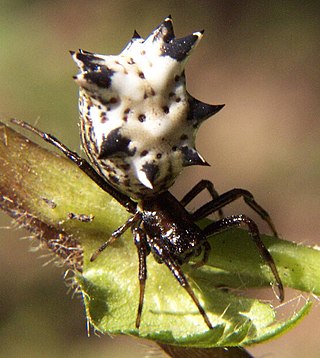
Micrathena gracilis is a spider in the family Araneidae (orb-weavers), commonly known as the spined micrathena or castleback orbweaver. This spider spins a moderately large and very tightly coiled web. The spiders themselves are small and can be found to be anywhere from 4.2 mm to 10.8 mm long. Its venom is harmless to humans. M. gracilis is unique in appearance due to its large spiky abdomen and black and white bodies. Certain spiders of this species can also display a yellow color on the sides of their bodies. These spiders can be seen most active during the end of the summer and beginning of fall. M. gracilis is diurnal and are rarely ever seen active at night.

Araneus is a genus of common orb-weaving spiders. It includes about 650 species, among which are the European garden spider and the barn spider. The genus was erected by Carl Alexander Clerck in 1757.
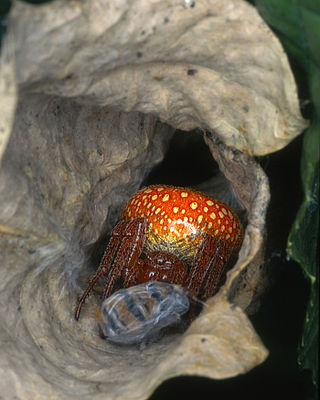
Araneus alsine, the strawberry spider or orange wheelweaving spider, is a species of the orb-weaving spider family, Araneidae.

Leucauge is a spider genus of long-jawed orb weavers, with over 160 species and fully pantropical distribution.
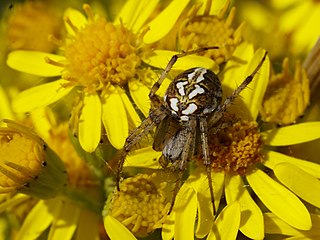
Neoscona, known as spotted orb-weavers and barn spiders, is a genus of orb-weaver spiders (Araneidae) first described by Eugène Simon in 1895 to separate these from other araneids in the now obsolete genus Epeira. The name Neoscona was derived from the Greek νέω, meaning "spin", and σχοῖνος, meaning "reed" They have a mostly pantropical distribution and one species, Neoscona adianta, has a palearctic distribution. As of April 2019 there are eight species that can be found in the United States and Canada:
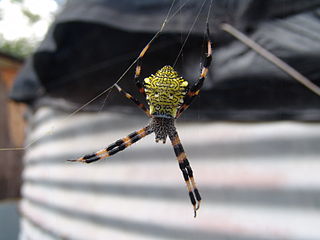
Argiope appensa, also referred to as the Hawaiian garden spider or banana spider, is an orb-weaving spider belonging to the family Araneidae.

Micrathena, known as spiny orbweavers, is a genus of orb-weaver spiders first described by Carl Jakob Sundevall in 1833. Micrathena contains more than a hundred species, most of them Neotropical woodland-dwelling species. The name is derived from the Greek "micro", meaning "small", and the goddess Athena.

Arkys, also known as triangular spider or ambush spider, is a genus of Australian araneomorph spiders in the family Arkyidae, first described by Charles Athanase Walckenaer in 1837. They are often small, with a triangular shaped abdomen, and are found in Australia and some of its surrounding islands. They don't build webs, but can often be found on leaves and tips of flower heads. Their egg sacs are pinkish-orange and spherical, and are made late in the summer.
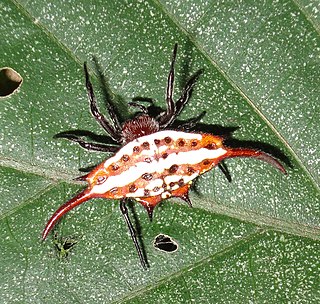
Gasteracantha versicolor, known as the long-winged kite spider, is a species of diurnal spiny orb-weaver of the family Araneidae. It is found in the tropics and sub-tropics, where it occurs in forests. It has an extensive range, from central, east and southern Africa to Madagascar.
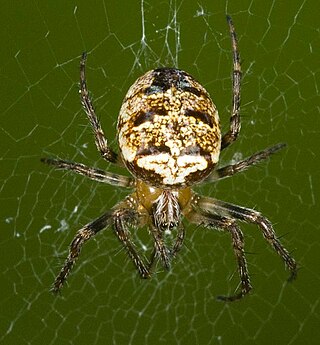
Zilla is a genus of orb-weaver spiders first described by C. L. Koch in 1834.

Nephila antipodiana, also known as the batik golden web spider, is a species of golden orb-web spider discovered in 1841 by Charles Athanase Walckenaer. The species is found throughout Australia, China, Indonesia, the Philippines, and Thailand. The spider's silk contains a pyrrolidine alkaloid which serves as a chemical repellent to keep ants away from the spider's web.

Mangora acalypha, also known by its common name cricket-bat orbweaver, is a species of spider in the family Araneidae, found throughout the Palearctic realm. This species was originally described by Charles Athanase Walckenaer in 1802 as Aranea acalypha.

Macracantha is a genus of Asian orb-weaver spiders recognized as containing the species, Macracantha arcuata., although some schemes also recognise inclusion of Gasteracantha hasselti in this genus. Macracantha is notable for the extremely long, curved spines on the abdomens of female members of the genus; Eugène Simon created the taxon name from the Greek words μακρός and ἄκανθα (spine). It occurs from India and China through Southeast Asia to Indonesia.

Pasilobus is a genus of orb-weaver spiders first described by Eugène Simon in 1895.

Argiope australis, the common garden orb web spider, is an orb-web spider.

Cyrtarachninae is a subfamily of spiders in the family Araneidae. The group has been circumscribed in several different ways. It originated as the group Cyrtarachneae, described by Eugène Simon in 1892. The group was later treated at different ranks: as a tribe, both under Simon's name and as Cyrtarachnini, and as the subfamily Cyrtarachninae. Circumscriptions have varied. The broadest circumscription, Cyrtarachninae sensu lato (s.l.), includes three of Simon's original groups, including the bolas spiders. Unlike most araneids, members of the subfamily do not construct orb webs, some not using webs at all to capture prey, some using one or more sticky drops on a single line, while others construct webs with few widely spaced non-spiral threads, some triangular. Many have been shown to attract prey by producing analogues of insect sex pheromones, particularly to attract male moths. Adult females may mimic snails, bird droppings and other objects, and so are able to remain exposed during the day time, capturing prey at night.




















